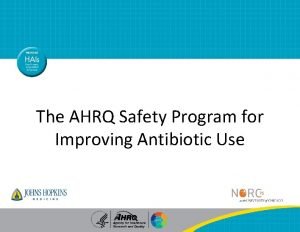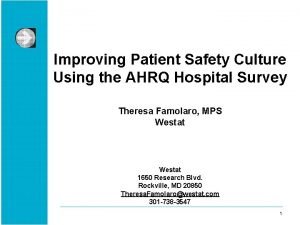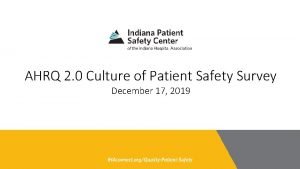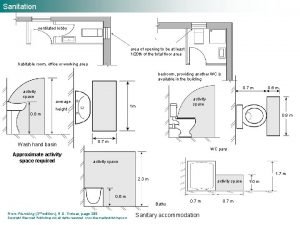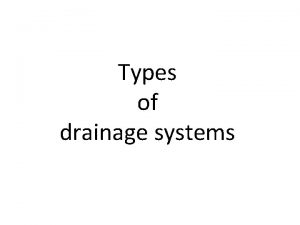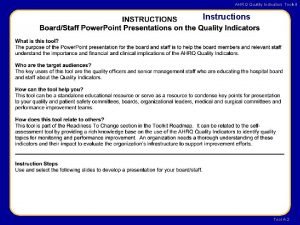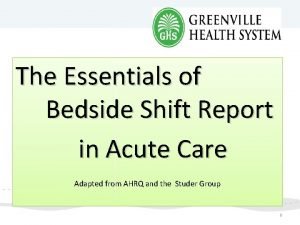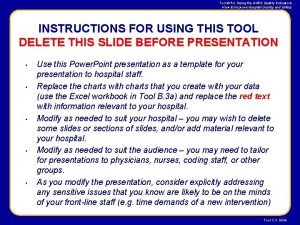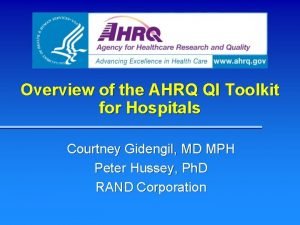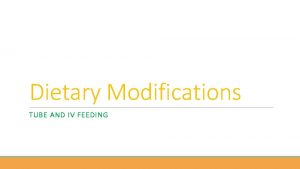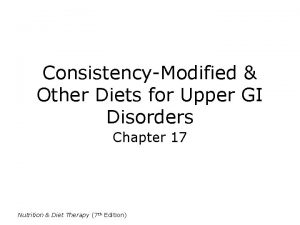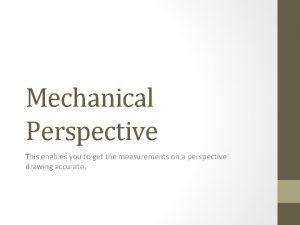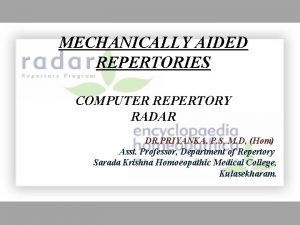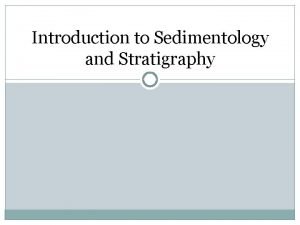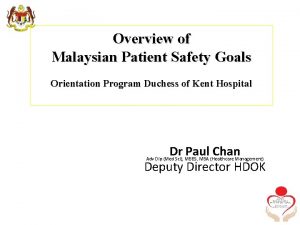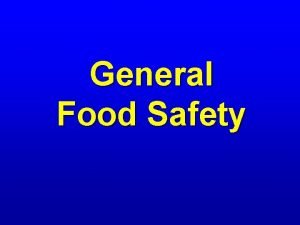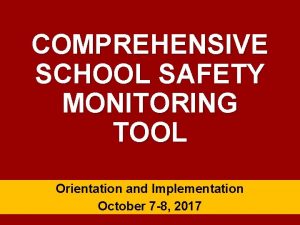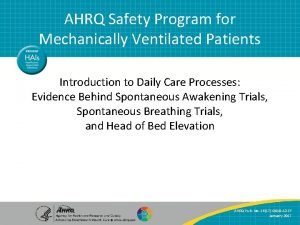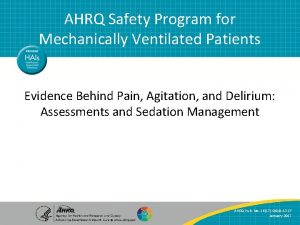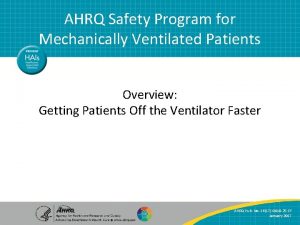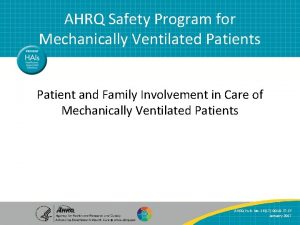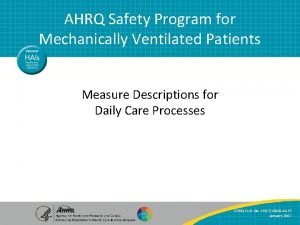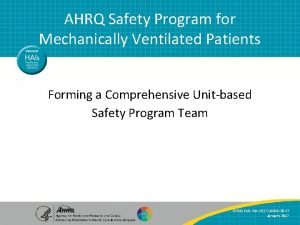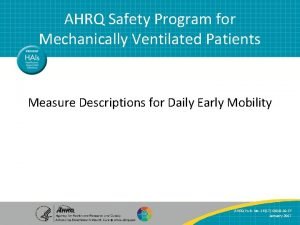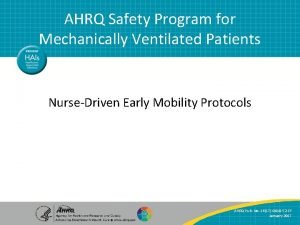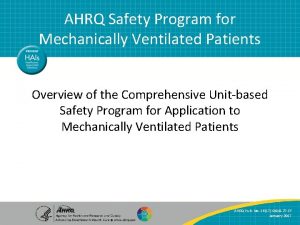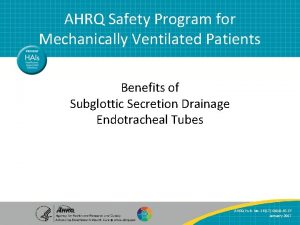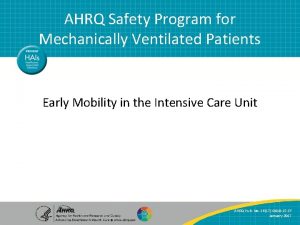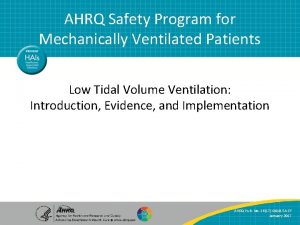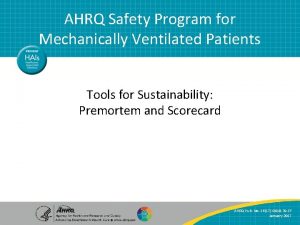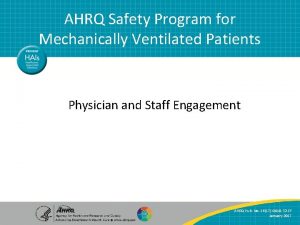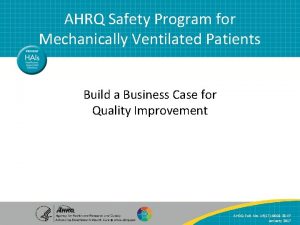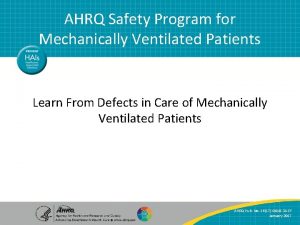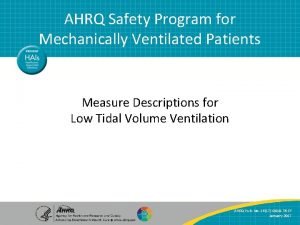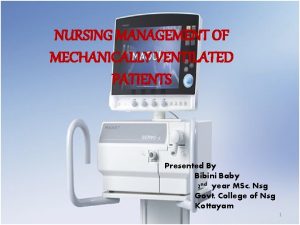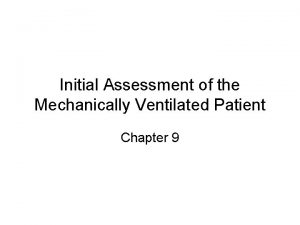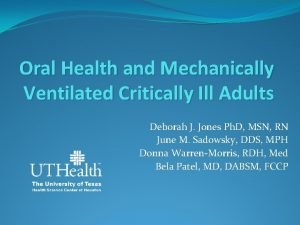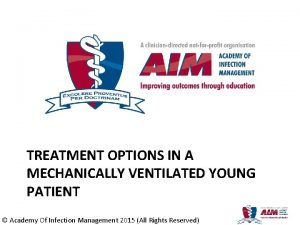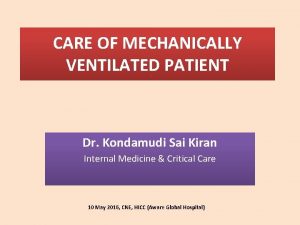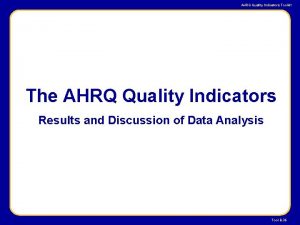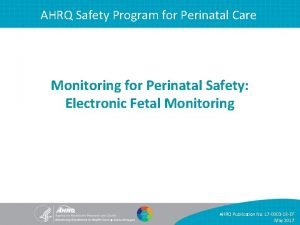AHRQ Safety Program for Mechanically Ventilated Patients Monitoring







































- Slides: 39

AHRQ Safety Program for Mechanically Ventilated Patients Monitoring Ventilator-Associated Events AHRQ Safety Program for Mechanically Ventilated Patients AHRQ Pub. No. 16(17)-0018 -26 -EF Monitoring VAEs 1 January 2017

Learning Objectives After this session, you will be able to— • Describe the impact of mechanical ventilation and ventilator-associated events (VAE) • Identify the definitions of VAE • Recognize the need for an accurate objective outcome measure for VAE • Correctly apply VAE diagnostic criteria to determine if a VAE has occurred AHRQ Safety Program for Mechanically Ventilated Patients Monitoring VAEs 2

Impact of Mechanical Ventilation • Affects 800, 000 hospitalized patients in the United States each year 1 • Five to 10 percent of ventilated patients develop a VAE 2, 3 1. Carson SS, Cox CE, Homes GM, et al. The changing epidemiology of mechanical ventilation: a population-based study. J Intensive Care Med. 2006; 21(3): 173 -82. PMID: 16672639. 2. Klompas M, Kleinman K, Murphy MV. Descriptive epidemiology and attributable morbidity of ventilator-associated events. Infect Control Hosp Epidemiol. 2014; 35(5): 502 -510. PMID: 24709718. 3. Klein Klouwenberg PM, van Mourik, Ong DS, et al: Electronic implementation of a novel surveillance paradigm for ventilator-associated events: feasibility and validation. Am J Respir Crit Care Med. 2014 Apr 15; 189(8): 947 -55. PMID: 24498886. AHRQ Safety Program for Mechanically Ventilated Patients Monitoring VAEs 3

Impact of Mechanical Ventilation • Historically, ventilator-associated pneumonia (VAP) was considered one of the most lethal healthcareassociated infections 4 • 35% mortality rate for ventilated patients 5 – 24% for patients 15– 19 years – 60% for patients 85 years and older 4. Safdar N, Dezfullian C, Collard HR, et al. Clinical and economic consequences of ventilator–associated pneumonia: a systematic review. Crit Care Med. 2005; 33(10): 2184 -93. PMID: 16215368. 5. Wunsch H, Linde-Zwirble WT, Angus DC, et al. The epidemiology of mechanical ventilation use in the United States. Crit Care Med. 2010; 38(10): 1947 -53. PMID: 20639743. AHRQ Safety Program for Mechanically Ventilated Patients Monitoring VAEs 4

Possible Complications of Mechanical Ventilation • VAE – Ventilator-associated condition (VAC) – Infection-related ventilator-associated condition (IVAC) – VAP • Acute Respiratory Distress Syndrome (ARDS) • Sepsis • Pulmonary embolism • Pulmonary edema • Barotrauma • And more AHRQ Safety Program for Mechanically Ventilated Patients Monitoring VAEs 5

Understanding the Impact of VAC Impact of Ventilator-Associated Conditions • VAC is typically attributable to pneumonia, pulmonary edema, atelectasis, or acute respiratory distress syndrome (ARDS)2 • VAC has a strong association with prolonged mechanical ventilation, length of stay, and mortality 6 2. Klompas M, Khan Y, Kleinman K, et al. Multicenter evaluation of a novel surveillance paradigm for complications of mechanical ventilation. PLo. S ONE. 2011 Mar 22; 6(3): e 18062. PMID: 21445364. 6. Hayashi Y, Morisawa K, Klompas M, et al. Toward improved surveillance: the impact of ventilator-associated complications on length of stay and antibiotic use in patients in intensive care units. Clin Infect Dis. 2013; 56(4): 471 -7. PMID: 23118272. AHRQ Safety Program for Mechanically Ventilated Patients Monitoring VAEs 6

Understanding the Impact of VAP Impact of Ventilator-Associated Pneumonia 4, 7 -12 • Crude mortality rate 30– 50% • Attributable mortality rate 8 – 12% • Adds $10, 000 to $50, 000 to cost of hospital stay • Increases intensive care unit length of stay by 4– 7 days • Increases hospital length of stay by 14 days 4. Safdar N, Dezfullian C, Collard HR, et al. Clinical and economic consequences of ventilator–associated pneumonia: a systematic review. Crit Care Med. 2005; 33(10): 2184 -93. PMID: 16215368. 7. Medicare Program: Proposed changes to the hospital inpatient prospective payment systems and fiscal year 2008 rates. CMS-1533 -P. Baltimore, MD: Centers for Medicare and Medicaid Services. May 2007. https: //www. cms. gov/Medicare-Fee-for. Service-Payment/Acute. Inpatient. PPS/downloads/cms-1533 -p. pdf. Accessed July 2015 8. Tejerina E, Frutos-Vivar F, Restrepo MI, et al. Incidence, risk factors, and outcome of ventilator-associated pneumonia. J Crit Care. 2006 Mar; 21(1): 56 -65. 16616625. 9. Muscedere JG, Martin CM, Heyland DK. The impact of ventilator-associated pneumonia on the Canadian health care system. J Crit Care. 2008 Mar; 23(1): 5 -10. PMID: 18359415. 10. Eber MR, Laxminarayan R, Perencevich EN, et al. Clinical and economic outcomes attributable to health care-associated sepsis and pneumonia. Arch Internal Med. 2010 Feb 22; 170(4): 347 -53. PMID: 20177037. 11. Nguile-Makao M, Zahar JR, Français A, et al. Attributable mortality of ventilatorassociated pneumonia: respective impact of main characteristics at ICU admission and VAP onset using conditional logistic regression and multi-state models. Intensive Care Med. 2010 May; 36(5): 781 -9. PMID: 20232046. 12. Beyersmann J, Gastmeier P, Grundmann H, et al. Use of multistate models to assess prolongation of intensive care unit stay due to nosocomial infection. Infect Control Hosp Epidemiol. 2006 May; 27(5): 493 -9. PMID: 16671031. AHRQ Safety Program for Mechanically Ventilated Patients Monitoring VAEs 7

Why Is This Work Important? VAE Attributable Hospital Mortality 2 OR = Odds ratio; CI = Confidence interval, P = P-value 2. Klompas M, Khan Y, Kleinman K, et al. Multicenter evaluation of a novel surveillance paradigm for complications of mechanical ventilation. PLo. S ONE. 2011 Mar 22; 6(3): e 18062. PMID: 21445364. AHRQ Safety Program for Mechanically Ventilated Patients Monitoring VAEs 8

National Health Safety Network VAE Definition • Objective • Streamlined • Potentially automatable • Defines a broad range of conditions and complications occurring in mechanically ventilated patients AHRQ Safety Program for Mechanically Ventilated Patients Monitoring VAEs 9

What Types of Mechanical Ventilation Are Included? • All types of mechanical ventilation, except— – High-frequency ventilation – Extracorporeal membrane oxygenation – Lung expansion devices, such as— • Intermittent positive pressure breathing • Nasal positive end-expiratory pressure (PEEP) • Nasal continuous positive airway pressure • Airway pressure release ventilation (APRV) and related modes are included but only fraction of inspired oxygen (Fi. O 2) values are used AHRQ Safety Program for Mechanically Ventilated Patients Monitoring VAEs 10

VAE Definition Tiers 13 Respiratory status component Patient on mechanical ventilation > 2 days Baseline period of stability or improvement, followed by sustained period of worsening oxygenation VAC Infection / inflammation component General evidence of infection/inflammation IVAC Additional evidence Positive results of microbiological testing Possible or Probable VAP 13. Device-associated module: ventilator-associated event. Atlanta, GA: Centers for Disease Control and Prevention. January 2014. http: //www. cdc. gov/nhsn/PDFs/psc. Manual/10 VAE_FINAL. pdf. Accessed September 21, 2015. AHRQ Safety Program for Mechanically Ventilated Patients Monitoring VAEs 11

VAC – Definition Criteria • Patient intubated for >2 calendar days (earliest day of event is calendar day 3) • Baseline stability – Stable or improving baseline period – The 2 calendar days immediately preceding the first day of increased oxygen requirement, defined as an increased daily minimum PEEP or Fi. O 2 AHRQ Safety Program for Mechanically Ventilated Patients Monitoring VAEs 12

VAC – Determination After period of stability or improvement on the ventilator, the patient exhibits at least one of these indicators of worsening oxygenation: • Daily minimum PEEP values increase ≥ 3 cm H 2 O over daily minimum for the preceding 2 calendar days • Daily minimum Fi. O 2 values increase ≥ 0. 20 over daily minimum for preceding 2 calendar days • PEEP or Fi. O 2 must be maintained for ≥ 1 hour (two consecutive hour readings) (see next slide for exceptions to this rule) AHRQ Safety Program for Mechanically Ventilated Patients Monitoring VAEs 13

VAC – Exceptions to 1 -Hour Rule • If PEEP or Fi. O 2 values are not recorded hourly, use lowest value • If PEEP or Fi. O 2 values are not stable for at least 1 hour, use the lowest value – Patient extubated early in the day – Patient admitted late in the day AHRQ Safety Program for Mechanically Ventilated Patients Monitoring VAEs 14

IVAC – Criterion 1 • Patient meets criteria for VAC (VAC must be determined before IVAC can be considered) • The patient must meet BOTH of the following criteria on or after calendar day 3 of mechanical ventilation AND within 2 calendar days before or after the onset of worsening oxygenation: – Criterion 1 • Temp > 38 o. C (100. 4 o. F) or < 36 o. C (96. 8 o. F), OR • White blood cell count ≥ 12, 000 cells/cubic millimeter (mm 3), OR • White blood cell count ≤ 4, 000 cells/cubic millimeter (mm 3) – Criterion 2 • A new antimicrobial agent(s) is started and continued for ≥ 4 calendar days AHRQ Safety Program for Mechanically Ventilated Patients Monitoring VAEs 15

IVAC – Criterion 2 • Patient meets criteria for VAC (VAC must be determined before IVAC can be considered) • The patient must meet BOTH of the following criteria on or after calendar day 3 of mechanical ventilation AND within 2 calendar days before or after the onset of worsening oxygenation: – Criterion 1 • Temp > 38 o. C (100. 4 o. F) or < 36 o. C (96. 8 o. F), OR • White blood cell count ≥ 12, 000 cells/cubic millimeter (mm 3), OR • White blood cell count ≤ 4, 000 cells/cubic millimeter (mm 3) – Criterion 2 • A new antimicrobial agent(s) is started and continued for ≥ 4 calendar days AHRQ Safety Program for Mechanically Ventilated Patients Monitoring VAEs 16

IVAC Antimicrobial Criteria Standardizes assessment method of antimicrobial therapy without the need for specific information, such as— • Drug dosing • Renal function • Indication for therapy AHRQ Safety Program for Mechanically Ventilated Patients Monitoring VAEs 17

IVAC – Antimicrobials Included Current • Antibacterials • Antifungals, limited antivirals Former • Broad range of agents for healthcareassociated infections, not just respiratory infections Listed in the CDC’s VAE Manual http: //www. cdc. gov/nhsn/PDFs/psc. Manual/10 -VAE_FINAL. pdf AHRQ Safety Program for Mechanically Ventilated Patients Monitoring VAEs 18

IVAC – Antimicrobials NOT Included • Anti-HIV agents • Anti-tuberculosis agents • Agents used to treat viral hepatitis • Agents used to treat herpes virus infection • Anti-parasitics AHRQ Safety Program for Mechanically Ventilated Patients Monitoring VAEs 19

Definition – New Antimicrobial Agent Any agent listed on slide 18 that is initiated in the VAE window period— • Was not given on either of the 2 days preceding the current start date • Must be continued for ≥ 4 consecutive days • Does not need to be the same antimicrobial agent for the 4 days • Can be considered continuous if a single day is skipped between two doses of the same agent • Must be administered intravenously, intramuscularly, via digestive tract, or via respiratory tract AHRQ Safety Program for Mechanically Ventilated Patients Monitoring VAEs 20

IVAC – New Antimicrobials NOT Included • Amantadine • Chloramphenicol • Nitrofurantoin • Daptomycin • Erythromycin • Oral cephalosporins • Erythromycin/ sulfisoxazole • Oral vancomycin • Rimantadine • Fidaxomicin • Tinidazole AHRQ Safety Program for Mechanically Ventilated Patients Monitoring VAEs 21

AHRQ Safety Program for Mechanically Ventilated Patients VAE: AN OBJECTIVE OUTCOME MEASURE AHRQ Safety Program for Mechanically Ventilated Patients Monitoring VAEs 22

Centers for Disease Control (CDC): Old Definition Centers for Disease Control (CDC): New Definition Infiltrate New antibiotic start Gram stain neutrophils Purulent secretions Increased vent settings Low Partial Pressure of Oxygen: Fi. O 2 ratio Low WBC High White Blood Cell Count (WBC) High Temperature Low Temperature Diagnostic Criteria for VAP 14 American College of Chest Physicians (ACCP) Criteria Clinical Pulmonary Infection Score (CPIS) Johanson Clinical Criteria Hospitals in Europe Link for Infection Control Through Surveillance (HELICS) Criteria 14. Ego A, Preiser JC, Vincent JL. Impact of diagnostic criteria on the incidence of ventilator-associated pneumonia. Chest. 2015; 147(2): 347 -55. PMID: 25340476. AHRQ Safety Program for Mechanically Ventilated Patients Monitoring VAEs 23

Impact of Diagnostic Criteria on VAP Prevalence 14 ACCP = American College of Chest Physicians; CDC = Centers for Disease Control and Prevention; CPIS = Clinical Pulmonary Infection Score; HELICS = Hospitals in Europe Link for Infection Control through Surveillance; Johanson Clinical Criteria AHRQ Safety Program for Mechanically Ventilated Patients 14. Ego A, Preiser JC, Vincent JL. Impact of diagnostic criteria on the incidence of ventilator-associated pneumonia. Chest. 2015; 147(2): 347 -55. PMID: 25340476. Monitoring VAEs 24

Inconsistency in VAP Diagnoses 15 84 ICU patients with abnormal chest x rays and purulent sputum Evaluated by seven physicians for VAP Establish objective diagnosis by histology or quantitative bronchoscopy cultures 32% of patients diagnosed with VAP 15. Fagon JY, Chastre J, Hance AJ, et al. Evaluation of clinical judgment in the identification and treatment of nosocomial pneumonia in ventilated patients. Chest. 1993; 103(2): 547 -53. PMID: 8432152. AHRQ Safety Program for Mechanically Ventilated Patients Monitoring VAEs 25

Inconsistency in VAP Diagnoses 15 28% 42% of physicians disagreed on presence or absence of VAP in 35/84 of patients of the MOST accurate doctors missed true VAPs 20% of patients misdiagnosed with VAP from both groups 50% of the LEAST accurate doctors missed true VAPs AHRQ Safety Program for Mechanically Ventilated Patients 15. Fagon JY, Chastre J, Hance AJ, et al. Evaluation of clinical judgment in the identification and treatment of nosocomial pneumonia in ventilated patients. Chest. 1993; 103(2): 547 -53. PMID: 8432152. Monitoring VAEs 26

AHRQ Safety Program for Mechanically Ventilated Patients DIAGNOSING A POTENTIAL VAC AHRQ Safety Program for Mechanically Ventilated Patients Monitoring VAEs 27

Let’s Find a VAC • Daily minimum PEEP values increase ≥ 3 cm water over daily minimum for the preceding 2 calendar days • Daily minimum Fi. O 2 values increase ≥ 0. 20 over daily minimum for preceding 2 calendar days AHRQ Safety Program for Mechanically Ventilated Patients Monitoring VAEs 28

Example 1 – PEEP Two days of stable PEEP, followed by a change in PEEP of ≥ 3. MV Day Min PEEP Min Fi. O 2 1 2 3 4 5 6 7 8 9 10 8 7 6 6 5 5 8 9 6 7 100 70 50 70 60 50 70 80 50 50 The change is maintained or worsens for ≥ 2 days. Is this a VAC? MV = Mechanical Ventilation, Min = Minimum AHRQ Safety Program for Mechanically Ventilated Patients Monitoring VAEs 29

Example 1 – PEEP Two days of stable PEEP, followed by a change in PEEP of ≥ 3. MV Day Min PEEP Min Fi. O 2 1 2 3 4 5 6 7 8 9 10 8 7 6 6 5 5 8 9 6 7 100 70 50 70 60 50 70 80 50 50 The change is maintained or worsens for ≥ 2 days. Is this a VAC? YES! This is a VAC! AHRQ Safety Program for Mechanically Ventilated Patients Monitoring VAEs 30

Example 2 – Fi. O 2 Two days of stable Fi. O 2, followed by a change in Fi. O 2 of ≥ 0. 20. The change is maintained or worsens for ≥ 2 days. Is this a VAC? MV Day 1 2 3 4 5 6 7 8 9 10 AHRQ Safety Program for Mechanically Ventilated Patients Min PEEP 8 7 6 6 5 5 6 6 6 7 Min Fi. O 2 100 70 50 50 70 70 70 80 50 50 Monitoring VAEs 31

Example 2 – Fi. O 2 Two days of stable Fi. O 2, followed by a change in Fi. O 2 of ≥ 0. 20. The change is maintained or worsens for ≥ 2 days. Is this a VAC? YES! This is a VAC! MV Day 1 2 3 4 5 6 7 8 9 10 AHRQ Safety Program for Mechanically Ventilated Patients Min PEEP 8 7 6 6 5 5 6 6 6 7 Min Fi. O 2 100 70 50 50 70 70 70 80 50 50 Monitoring VAEs 32

Example 3 Examine the PEEP and Fi. O 2 values… Is this a VAC? MV Day 1 2 3 4 5 6 7 8 9 10 AHRQ Safety Program for Mechanically Ventilated Patients Min PEEP 8 7 6 6 5 5 6 6 6 7 Min Fi. O 2 100 70 55 50 70 70 70 80 50 50 Monitoring VAEs 33

Example 3 NO! This is not a VAC! Why not? 1. There is no increase of ≥ 3 for the minimum PEEP at any time. 2. There is no 2 -day stability period in Fi. O 2 before the. 20 increase. MV Day 1 2 3 4 5 6 7 8 9 10 AHRQ Safety Program for Mechanically Ventilated Patients Min PEEP 8 7 6 6 5 5 6 6 6 7 Min Fi. O 2 100 70 55 50 70 70 70 80 50 50 Monitoring VAEs 34

Questions? AHRQ Safety Program for Mechanically Ventilated Patients Monitoring VAEs 35

References 1. Carson SS, Cox CE, Homes GM, et al. The changing epidemiology of mechanical ventilation: a population-based study. J Intensive Care Med. 2006; 21(3): 173 -82. PMID: 16672639. 2. Klompas M, Kleinman K, Murphy MV. Descriptive epidemiology and attributable morbidity of ventilator-associated events. Infect Control Hosp Epidemiol. 2014; 35(5): 502 -510. PMID: 24709718. 3. Klein Klouwenberg PM, van Mourik, Ong DS, et al: Electronic implementation of a novel surveillance paradigm for ventilatorassociated events: feasibility and validation. Am J Respir Crit Care Med. 2014 Apr 15; 189(8): 947 -55. PMID: 24498886 4. Safdar N, Dezfullian C, Collard HR, et al. Clinical and economic consequences of ventilator-associated pneumonia: a systematic review. Crit Care Med. 2005; 33(10): 2184 -93. PMID: 16215368. AHRQ Safety Program for Mechanically Ventilated Patients Monitoring VAEs 36

References 5. Wunsch H, Linde-Zwirble WT, Angus DC, et al. The epidemiology of mechanical ventilation use in the United States. Crit Care Med. 2010; 38(10): 1947 -53. PMID: 20639743. 6. Hayashi Y, Morisawa K, Klompas M, et al. Toward improved surveillance: the impact of ventilator-associated complications on length of stay and antibiotic use in patients in intensive care units. Clin Infect Dis. 2013; 56(4): 471 -7. PMID: 23118272. 7. Medicare Program: Proposed changes to the hospital inpatient prospective payment systems and fiscal year 2008 rates. CMS-1533 -P. Baltimore, MD: Centers for Medicare and Medicaid Services. May 2007. https: //www. cms. gov/Medicare-Fee-for-Service. Payment/Acute. Inpatient. PPS/downloads/cms-1533 -p. pdf. Accessed July 2015. AHRQ Safety Program for Mechanically Ventilated Patients Monitoring VAEs 37

References 8. Tejerina E, Frutos-Vivar F, Restrepo MI, et al. Incidence, risk factors, and outcome of ventilator-associated pneumonia. J Crit Care. 2006 Mar; 21(1): 56 -65. 16616625. 9. Muscedere JG, Martin CM, Heyland DK. The impact of ventilatorassociated pneumonia on the Canadian health care system. J Crit Care. 2008 Mar; 23(1): 5 -10. PMID: 18359415. 10. Eber MR, Laxminarayan R, Perencevich EN, et al. Clinical and economic outcomes attributable to health care-associated sepsis and pneumonia. Arch Internal Med. 2010 Feb 22; 170(4): 347 -53. PMID: 20177037. 11. Nguile-Makao M, Zahar JR, Français A, et al. Attributable mortality of ventilator-associated pneumonia: respective impact of main characteristics at ICU admission and VAP onset using conditional logistic regression and multi-state models. Intensive Care Med. 2010 May; 36(5): 781 -9. PMID: 20232046. AHRQ Safety Program for Mechanically Ventilated Patients Monitoring VAEs 38

References 12. Beyersmann J, Gastmeier P, Grundmann H, et al. Use of multistate models to assess prolongation of intensive care unit stay due to nosocomial infection. Infect Control Hosp Epidemiol. 2006 May; 27(5): 493 -9. PMID: 16671031. 13. Device-associated module: ventilator-associated event. Atlanta, GA: Centers for Disease Control and Prevention. January 2014. http: //www. cdc. gov/nhsn/PDFs/psc. Manual/10 -VAE_FINAL. pdf. Accessed September 21, 2015. 14. Ego A, Preiser JC, Vincent JL. Impact of diagnostic criteria on the incidence of ventilator-associated pneumonia. Chest. 2015; 147(2): 34755. PMID: 25340476. 15. Fagon JY, Chastre J, Hance AJ, et al. Evaluation of clinical judgment in the identification and treatment of nosocomial pneumonia in ventilated patients. Chest. 1993; 103(2): 547 -53. PMID: 8432152. AHRQ Safety Program for Mechanically Ventilated Patients Monitoring VAEs 39
 Ahrq safety program for improving antibiotic use
Ahrq safety program for improving antibiotic use Ahrq safety culture survey
Ahrq safety culture survey Ahrq patient safety survey
Ahrq patient safety survey Domical cage
Domical cage Single pipe system
Single pipe system Ahrq quality indicators
Ahrq quality indicators Ahrq bedside shift report
Ahrq bedside shift report Ahrq quality indicators toolkit
Ahrq quality indicators toolkit Ahrq qi
Ahrq qi Mechanically inclined skills
Mechanically inclined skills Example of altered feeding routes
Example of altered feeding routes Dietary adjustments after a gastrectomy are influenced by
Dietary adjustments after a gastrectomy are influenced by Mechanical perspective drawing
Mechanical perspective drawing Mechanical aided repertory
Mechanical aided repertory What are sediments
What are sediments Head loss through bar screen
Head loss through bar screen Patient safety goals kkm
Patient safety goals kkm Jack in the box
Jack in the box Comprehensive school safety monitoring tool
Comprehensive school safety monitoring tool Fspos vägledning för kontinuitetshantering
Fspos vägledning för kontinuitetshantering Novell typiska drag
Novell typiska drag Tack för att ni lyssnade bild
Tack för att ni lyssnade bild Ekologiskt fotavtryck
Ekologiskt fotavtryck Varför kallas perioden 1918-1939 för mellankrigstiden
Varför kallas perioden 1918-1939 för mellankrigstiden En lathund för arbete med kontinuitetshantering
En lathund för arbete med kontinuitetshantering Adressändring ideell förening
Adressändring ideell förening Vilotidsbok
Vilotidsbok A gastrica
A gastrica Förklara densitet för barn
Förklara densitet för barn Datorkunskap för nybörjare
Datorkunskap för nybörjare Stig kerman
Stig kerman Mall för debattartikel
Mall för debattartikel Delegerande ledarskap
Delegerande ledarskap Nyckelkompetenser för livslångt lärande
Nyckelkompetenser för livslångt lärande Påbyggnader för flakfordon
Påbyggnader för flakfordon Kraft per area
Kraft per area Publik sektor
Publik sektor Urban torhamn
Urban torhamn Presentera för publik crossboss
Presentera för publik crossboss Argument för teckenspråk som minoritetsspråk
Argument för teckenspråk som minoritetsspråk
